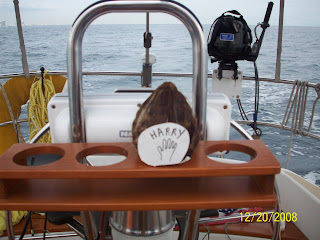Elizabeth City was a nice surprise. The breeze was up from the southwest, allowing a great sail across the Albemarle Sound - straight up the river into one of the free downtown boat slips. Every small waterfront town should take a lesson from Elizabeth City: A neat line of boats all full of hungry travelers had wedged into every available free slip along the waterfront. Part of the popularity was because of a regatta being held there next day, but mostly it was because sailors love nothing more than a free dock near restaurants. To top it off, there is an old tradition on the waterfront known as the "Rose Buddies." This is a small organized group of retired folks who host a 4:30 wine and cheese reception under a tent adjacent to the boat slips. They do it for the boaters, and they do it whenever there are more than five boats visiting. The ladies are each presented with a rose cut from the garden belonging to the original founder of the Rose Buddies tradition, hence the name. One of the local elders delivers a ten minute overview of the history of the EC waterfront, and some useful information regarding the waters that lie ahead. Very charming. Both of our daughters, E (along with Nick) and HA drove down to meet us for dinner, and HA stayed aboard to make the last two-day leg of the trip with us. It was great to be greeted home by our girls.
Last September, on a perfect day nearer the beginning of this adventure, we were screaming down the coast of New Jersey under full sail when we caught up with, and passed, another sailboat headed in the same direction. We anchored near each other in a cove in Atlantic City, and of course struck up a conversation, if shouts across the water can be considered a conversation. A couple of days later, there they were again, anchored in Cape May and we shouted our mutual hellos. Months later, we are motoring into Boot Key Harbor and there again is KISMET, a gorgeous Island Packet 35 that was obviously well equipped for living aboard. I kept telling K that I wanted to dinghy over and introduce myself, but there was never a good opportunity. Well, here I am standing on the wharf at Elizabeth City as the Rose Buddies reception is breaking up, and I see a great looking boat coming in, cutting a wake and glinting in the sun. Right away I knew it was either an Island Packet or a fairly new Caliber. As it drew closer I soon recognized the familiar blonde head of the captain and the fold-up dinghy being towed along. After finally meeting Jim and Laurie aboard KISMET, the four of us had dinner together the following night after motoring together up the Dismal Swamp canal. As we said our goodbyes on the VHF radio while parting ways in Hampton Roads harbor I thought to myself - another great couple out on their adventure; after a while, these people all start to feel like extended family. And every now and then you run across a little place like Elizabeth City where everything seems to come together.







